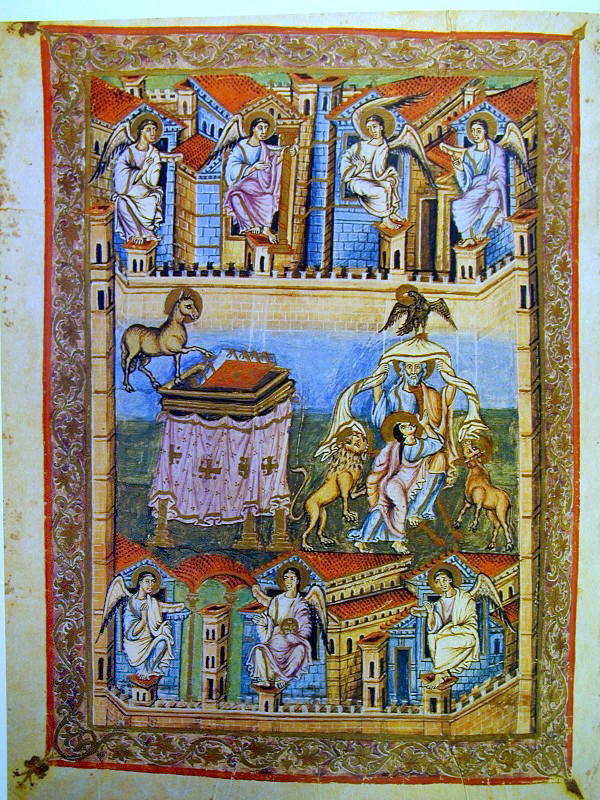|
Jacomijne Costers
Jacomijne Costers (c. 1462 – 1503) was a nun and author whose vision of the afterlife, shown during a near-death experience, was written down in ''Visioen en exempel'' ("Vision and Exemplum"). Biography Costers lived in the Facons Monastery in Antwerp. Facons, originally called ''Valkenbroek'', was a convent belonging to the Augustinian Congregation of Windesheim, and at the end of the 15th century there were concerns about the apparent lax discipline in the convent. In 1489 the plague struck the convent, and Jacomijne Costers was one of its victims. She survived, but was shown a vision in which devils took her to face Christ. These devils asserted a right to her sinful soul, and initially Christ seemed to agree with them; the intervention of Mary (besides her patron saint John the Evangelist and Augustine, patron saint of her order) saved her. She was sent through hell and purgatory, and given the assignment to recount her vision to help restore spiritual order to her house. ... [...More Info...] [...Related Items...] OR: [Wikipedia] [Google] [Baidu] |
Book Of Revelation
The Book of Revelation is the final book of the New Testament (and consequently the final book of the Christian Bible). Its title is derived from the first word of the Koine Greek text: , meaning "unveiling" or "revelation". The Book of Revelation is the only apocalyptic book in the New Testament canon. It occupies a central place in Christian eschatology. The author names himself as simply "John" in the text, but his precise identity remains a point of academic debate. Second-century Christian writers such as Papias of Hierapolis, Justin Martyr, Irenaeus, Melito of Sardis, Clement of Alexandria, and the author of the Muratorian fragment identify John the Apostle as the "John" of Revelation. Modern scholarship generally takes a different view, with many considering that nothing can be known about the author except that he was a Christian prophet. Modern theological scholars characterize the Book of Revelation's author as " John of Patmos". The bulk of tradition ... [...More Info...] [...Related Items...] OR: [Wikipedia] [Google] [Baidu] |
Women Religious Writers
A woman is an adult female human. Prior to adulthood, a female human is referred to as a girl (a female child or adolescent). The plural ''women'' is sometimes used in certain phrases such as "women's rights" to denote female humans regardless of age. Typically, women inherit a pair of X chromosomes, one from each parent, and are capable of pregnancy and giving birth from puberty until menopause. More generally, sex differentiation of the female fetus is governed by the lack of a present, or functioning, SRY-gene on either one of the respective sex chromosomes. Female anatomy is distinguished from male anatomy by the female reproductive system, which includes the ovaries, fallopian tubes, uterus, vagina, and vulva. A fully developed woman generally has a wider pelvis, broader hips, and larger breasts than an adult man. Women have significantly less facial and other body hair, have a higher body fat composition, and are on average shorter and less muscular than men. Thro ... [...More Info...] [...Related Items...] OR: [Wikipedia] [Google] [Baidu] |
15th-century Christian Nuns
The 15th century was the century which spans the Julian dates from 1 January 1401 ( MCDI) to 31 December 1500 ( MD). In Europe, the 15th century includes parts of the Late Middle Ages, the Early Renaissance, and the early modern period. Many technological, social and cultural developments of the 15th century can in retrospect be seen as heralding the " European miracle" of the following centuries. The architectural perspective, and the modern fields which are known today as banking and accounting were founded in Italy. The Hundred Years' War ended with a decisive French victory over the English in the Battle of Castillon. Financial troubles in England following the conflict resulted in the Wars of the Roses, a series of dynastic wars for the throne of England. The conflicts ended with the defeat of Richard III by Henry VII at the Battle of Bosworth Field, establishing the Tudor dynasty in the later part of the century. Constantinople, known as the capital of the world a ... [...More Info...] [...Related Items...] OR: [Wikipedia] [Google] [Baidu] |
16th-century Writers
The 16th century begins with the Julian year 1501 ( MDI) and ends with either the Julian or the Gregorian year 1600 ( MDC) (depending on the reckoning used; the Gregorian calendar introduced a lapse of 10 days in October 1582). The 16th century is regarded by historians as the century which saw the rise of Western civilization and the Islamic gunpowder empires. The Renaissance in Italy and Europe saw the emergence of important artists, authors and scientists, and led to the foundation of important subjects which include accounting and political science. Copernicus proposed the heliocentric universe, which was met with strong resistance, and Tycho Brahe refuted the theory of celestial spheres through observational measurement of the 1572 appearance of a Milky Way supernova. These events directly challenged the long-held notion of an immutable universe supported by Ptolemy and Aristotle, and led to major revolutions in astronomy and science. Galileo Galilei became a champion o ... [...More Info...] [...Related Items...] OR: [Wikipedia] [Google] [Baidu] |
Augustinian Nuns
Augustinian nuns are the most ancient and continuous segment of the Roman Catholic Augustinian religious order under the canons of contemporary historical method. The Augustinian nuns, named after Saint Augustine of Hippo (died AD 430), are several Roman Catholic enclosed monastic communities of women living according to a guide to religious life known as the Rule of St. Augustine. Prominent Augustinian nuns include Italian mystic St. Clare of Montefalco and St. Rita of Cascia. History Though Augustine of Hippo probably didn't compose a formal monastic rule (despite the extant Augustinian Rule),Augustine of Hippo The Rule of St Augustine Constitutiones Ordinis Fratrum S. Augustini (Rome 1968) his hortatory letter to the nuns at Hippo Regius (''Epist''., ccxi, Benedictine ed.) is the most ancient example on which the beginnings of this Augustinian Rule are based. The nuns regard as their first foundation the monastery for which St. Augustine wrote the rules of life in his ''Epi ... [...More Info...] [...Related Items...] OR: [Wikipedia] [Google] [Baidu] |
1503 Deaths
Fifteen or 15 may refer to: * 15 (number), the natural number following 14 and preceding 16 *one of the years 15 BC, AD 15, 1915, 2015 Music *Fifteen (band), a punk rock band Albums * ''15'' (Buckcherry album), 2005 * ''15'' (Ani Lorak album), 2007 * ''15'' (Phatfish album), 2008 * ''15'' (mixtape), a 2018 mixtape by Bhad Bhabie * ''Fifteen'' (Green River Ordinance album), 2016 * ''Fifteen'' (The Wailin' Jennys album), 2017 * ''Fifteen'', a 2012 album by Colin James Songs * "Fifteen" (song), a 2008 song by Taylor Swift *"Fifteen", a song by Harry Belafonte from the album '' Love Is a Gentle Thing'' *"15", a song by Rilo Kiley from the album '' Under the Blacklight'' *"15", a song by Marilyn Manson from the album ''The High End of Low'' *" The 15th", a 1979 song by Wire Other uses *Fifteen, Ohio, a community in the United States * ''15'' (film), a 2003 Singaporean film * ''Fifteen'' (TV series), international release name of ''Hillside'', a Canadian-American teen drama ... [...More Info...] [...Related Items...] OR: [Wikipedia] [Google] [Baidu] |
Saint Anne
According to Christian apocryphal and Islamic tradition, Saint Anne was the mother of Mary and the maternal grandmother of Jesus. Mary's mother is not named in the canonical gospels. In writing, Anne's name and that of her husband Joachim come only from New Testament apocrypha, of which the Gospel of James (written perhaps around 150) seems to be the earliest that mentions them. The mother of Mary is mentioned but not named in the Quran. Christian tradition The story is similar to that of Samuel, whose mother Hannah ( he, ''Ḥannāh'' "favour, grace"; etymologically the same name as Anne) had also been childless. The Immaculate Conception was eventually made dogma by the Catholic Church following an increased devotion to Anne in the 12th century. Dedications to Anne in Eastern Christianity occur as early as the 6th century. In the Eastern Orthodox tradition, Anne and Joachim are ascribed the title ''Ancestors of God'', and both the Nativity of Mary and the Presenta ... [...More Info...] [...Related Items...] OR: [Wikipedia] [Google] [Baidu] |
Golden Legend
The ''Golden Legend'' (Latin: ''Legenda aurea'' or ''Legenda sanctorum'') is a collection of hagiographies by Jacobus de Voragine that was widely read in late medieval Europe. More than a thousand manuscripts of the text have survived.Hilary Maddocks, "Pictures for aristocrats: the manuscripts of the ''Légende dorée''", in Margaret M. Manion, Bernard James Muir, eds. ''Medieval texts and images: studies of manuscripts from the Middle Ages'' 1991:2; a study of the systemization of the Latin manuscripts of the ''Legenda aurea'' is B. Fleith, "Le classement des quelque 1000 manuscrits de la Legenda aurea latine en vue de l'éstablissement d'une histoire de la tradition" in Brenda Dunn-Lardeau, ed. ''Legenda Aurea: sept siècles de diffusion", 1986:19-24 It was likely compiled around the years 1259–1266, although the text was added to over the centuries. Initially entitled ''Legenda sanctorum'' (''Readings of the Saints''), it gained its popularity under the title by which ... [...More Info...] [...Related Items...] OR: [Wikipedia] [Google] [Baidu] |
Epistles Of John
The Johannine epistles, the Epistles of John, or the Letters of John are three of the catholic epistles of the New Testament, thought to have been written between 85 and 100 AD. Most scholars agree that all three letters are written by the same author, although there is debate on who that author is. First This epistle, unlike the other two, is written more as a sermon, one to help strengthen people's faith in Jesus, to help them understand why a being as great as the Son of God would have a mortal life and a mortal's agonizing death. Second This epistle is written as a short letter from "the elder" to an unnamed "elect lady" whom he loves and her children. Within the letter, John warns about opening her home to false teachers and to always practice truth, avoiding secrecy. Third The third epistle, also a short letter from "the elder", is addressed to a man named Gaius and mentioned as "a dear friend". It talks about a man named Diotrephes whom Gaius excommunicated from th ... [...More Info...] [...Related Items...] OR: [Wikipedia] [Google] [Baidu] |
Antwerp
Antwerp (; nl, Antwerpen ; french: Anvers ; es, Amberes) is the largest city in Belgium by area at and the capital of Antwerp Province in the Flemish Region. With a population of 520,504,Statistics Belgium; ''Loop van de bevolking per gemeente'' (Excel file) Population of all municipalities in Belgium, . Retrieved 1 November 2017. it is the most populous municipality in Belgium, and with a metropolitan population of around 1,200,000 people, it is the second-largest ... [...More Info...] [...Related Items...] OR: [Wikipedia] [Google] [Baidu] |
Gospel Of John
The Gospel of John ( grc, Εὐαγγέλιον κατὰ Ἰωάννην, translit=Euangélion katà Iōánnēn) is the fourth of the four canonical gospels. It contains a highly schematic account of the ministry of Jesus, with seven "signs" culminating in the raising of Lazarus (foreshadowing the resurrection of Jesus) and seven "I am" discourses (concerned with issues of the Split of early Christianity and Judaism, church–synagogue debate at the time of composition) culminating in Doubting Thomas, Thomas' proclamation of the risen Jesus as "my Lord and my God". The gospel's concluding verses set out its purpose, "that you may believe that Jesus is the Christ, the Son of God, and that believing you may have life in his name." John reached its final form around AD 90–110, although it contains signs of origins dating back to AD 70 and possibly even earlier. Like the three other gospels, it is anonymous, although it identifies an unnamed "disciple whom Jesus loved" as t ... [...More Info...] [...Related Items...] OR: [Wikipedia] [Google] [Baidu] |

.jpg)





